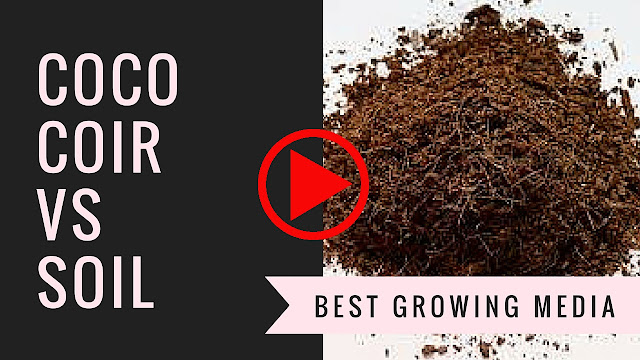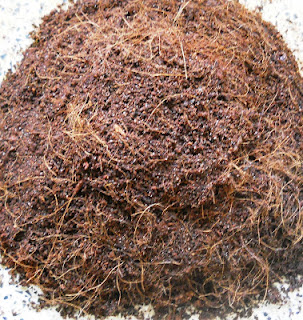This blog follows my previous blogs on soil-less growing media and Peat moss. After Peat Moss, now it is time for its alternative, Coconut Coir or coco coir. Now a days many of us are trying coconut coir as an alternative to peat moss due to several reasons, most important of which is it is much more environment friendly than peat moss. For an organic gardener it is crucial to make use of the things which are renewable.

 Origin of Coco Coir
Origin of Coco Coir
The English word "coir" comes from the Tamil and Malayalam word kayaru. which mean cord, to be twisted. In a coconut the husk portion(between the hard inner shell and the outer coat of the coconut) is the place from where the coir are extracted. Coir fibres make up about a third of the coconut husk, The rest, called peat, pith or dust.
Coir Fiber can be of two types white fibre and Brown fiber. White fibres are extracted from green coconut while we get the brown fibres when those are extracted from the fully matured coconut. The white fibre are the used in manufacturing rope, mats, and fishing nets(due to its resistance to saltwater). Brown Fibre is used to prepare doormats, brushes, mattress and also for insulation and packaging. The process of taking out the husk from the fruit is also known as De-husking.
The second part of the husk which covers the majority of the portion is known as coconut Coir, (or coir) or Coco peat (cocopeat). Once considered as waste

Coir does provide a suitable substrate for horticultural use as a soil-less potting media. As coir is high in sodium and potassium, and sometimes contains excess salt, it needs to be treated before using as a growth medium for plants. It is first washed, screened and graded into various granularity and density.
India and Sri lanka produces most of the coir in the world. Apart from these two, Mexico, Indonesia, Vietnam etc have also started producing coir now a days.
Coir can be of two types viz, sterilized and unsterilized. In case of sterilized coir peat the fungi Trichoderma is not present due to sterilization. Trichoderma work in symbiosis with plant roots and protect the plant from harmful pathogenic fungi such as pythium. That is one of the reason people now a days are shifting from using sterilized to unsterilized one.
Coco Coir Uses:
Coconut coir can be used almost anywhere you can use peat moss such as seed starters, bedding, gardens, container etc. It is resistant to bacterial and fungal growth. It provides all new opportunities for potting mix suppliers, seedling nurseries, Hydro-phonic growers and green house growers.In horticulture and gardening, coconut coir is a strongly recommended substitute for Peat moss because it is free of bacteria and fungal spores.As a substitute it helps slowing down peat extraction from environmentally sensitive swamps worldwide. It also has very good water retention and suitable aeration facility which helps to faster growth of roots.
Coco Coir contains a good amount of cellulose and lignin. As mushroom thrive on Cellulose, coir is used as a substrate to cultivate Mushrooms.
Coir generally have a pH level in the range of 6-6.5. which is very good pH level for most of the plants.

You can not use coir as a sole component in the medium to grow plants. The nutrient content in it is very low. If you insists growing solely on coir, you need to add nutrients as per the need of the specific plants. Coir from countries like India and Sri Lanka though contains several macro and micro-plant nutrients including substantial quantities of potassium, which interfere with the magnesium availability of the soil.
Generally, coir has a deficiency of Calcium and Magnesium, so adding a good amount of dolomite (which contains both of those elements) can be a very good idea.
Apart from agricultural usage dry coir can be used as an oil absorbent specially on slippery floors as it has very good absorbing ability. It is also used to absorb animal waste.
Coir is hydrophilic unlike peat moss and can quickly re-absorb water even when completely dry. Coco peat is porous and cannot be over watered easily. Coconut coir is not only a natural, organic product, but unlike peat moss a renewable one.
COCOPEAT BLOCK - EXPANDS TO 24 KG COCO PEAT POWDER
Like the article? Why not share it with others:
Related Articles on Coco Coir:
Why you should grow strawberries in Coir?Different soilless media for growing plants
A Miracle grow called Organic Potting Soil: The best soilless potting Mix
0 komentar:
Posting Komentar